An Automated Framework for Interaction Analysis of Driving Factors on Soil Salinization in Central Asia and Western China
Abstract
1. Introduction
2. Materials and Methods
2.1. Study Areas
2.2. Ground Sampling Data Acquisition
2.3. Environmental Variable Extraction
2.4. Automated Soil Salinization Prediction Model
2.5. Relationship Analysis Between SSC and Environmental Variables
2.5.1. Model Interpretation Based on the Post Hoc Interpretation Algorithm
2.5.2. Correlation Visualization Based on Knowledge Graph
2.6. Model Evaluation
3. Results
3.1. Accuracy Evaluation of the Automated Model
3.2. Interaction Effects Visualization Between the Individual Environmental Variables
3.3. Interaction Effects Visualization Between the Group Environmental Variables
3.4. Spatiotemporal Variation of SSC in Historical and Future Under Climate Change
3.4.1. Spatial Variation in Multiple Periods Under Different Scenarios
3.4.2. Long-Term Variation of the Study Area Under Different Scenarios
4. Discussion
4.1. Importance of Long-Term Climate Change on Salt-Affected Soils at Regional Scale
4.2. The Prospects and Limitations of This Automated Soil Salinity Study
4.2.1. Uncertainty of the Data-Driven Model
4.2.2. Uncertainty of the Feature Selection Process
4.2.3. Scale Effects of Soil Salinization
5. Conclusions
Supplementary Materials
Author Contributions
Funding
Data Availability Statement
Conflicts of Interest
References
- Hassani, A.; Azapagic, A.; Shokri, N. Global predictions of primary soil salinization under changing climate in the 21st century. Nat. Commun. 2021, 12, 6663. [Google Scholar] [CrossRef]
- Wang, J.Z.; Ding, J.L.; Yu, D.L.; Ma, X.K.; Zhang, Z.P.; Ge, X.Y.; Teng, D.X.; Li, X.H.; Liang, J.; Lizag, A.; et al. Capability of Sentinel-2 MSI data for monitoring and mapping of soil salinity in dry and wet seasons in the Ebinur Lake region, Xinjiang, China. Geoderma 2019, 353, 172–187. [Google Scholar] [CrossRef]
- Zhao, W.J.; Ma, H.; Zhou, C.; Zhou, C.Q.; Li, Z.L. Soil Salinity Inversion Model Based on BPNN Optimization Algorithm for UAV Multispectral Remote Sensing. IEEE J. Sel. Top. Appl. Earth Obs. Remote Sens. 2023, 16, 6038–6047. [Google Scholar] [CrossRef]
- Wang, N.; Peng, J.; Xue, J.; Zhang, X.L.; Huang, J.Y.; Biswas, A.; He, Y.; Shi, Z. A framework for determining the total salt content of soil profiles using time-series Sentinel-2 images and a random forest-temporal convolution network. Geoderma 2022, 409, 115656. [Google Scholar] [CrossRef]
- Castro, F.C.; Araújo, J.F.; dos Santos, A.M. Susceptibility to soil salinization in the quilombola community of Cupira—Santa Maria da Boa Vista—Pernambuco—Brazil. Catena 2019, 179, 175–183. [Google Scholar] [CrossRef]
- Mukhopadhyay, R.; Sarkar, B.; Jat, H.S.; Sharma, P.C.; Bolan, N.S. Soil salinity under climate change: Challenges for sustainable agriculture and food security. J. Environ. Manag. 2021, 280, 111736. [Google Scholar] [CrossRef]
- FAO. Global Status of Salt-Affected Soils; Food and Agriculture Organization of the United Nations: Rome, Italy, 2024; Available online: https://openknowledge.fao.org/handle/20.500.14283/cd3044en (accessed on 15 December 2024).
- Wang, Z.; Zhang, X.L.; Zhang, F.; Chan, N.W.; Kung, H.T.; Liu, S.H.; Deng, L.F. Estimation of soil salt content using machine learning techniques based on remote-sensing fractional derivatives, a case study in the Ebinur Lake Wetland National Nature Reserve, Northwest China. Ecol. Indic. 2020, 119, 106869. [Google Scholar] [CrossRef]
- Zhang, Y.T.; Hou, K.; Qian, H.; Gao, Y.Y.; Fang, Y.; Xiao, S.; Tang, S.Q.; Zhang, Q.Y.; Qu, W.A.; Ren, W.H. Characterization of soil salinization and its driving factors in a typical irrigation area of Northwest China. Sci. Total Environ. 2022, 837, 155808. [Google Scholar] [CrossRef]
- Gorji, T.; Sertel, E.; Tanik, A. Monitoring soil salinity via remote sensing technology under data scarce conditions: A case study from Turkey. Ecol. Indic. 2017, 74, 384–391. [Google Scholar] [CrossRef]
- Li, Y.S.; Chang, C.Y.; Wang, Z.R.; Zhao, G.X. Upscaling remote sensing inversion and dynamic monitoring of soil salinization in the Yellow River Delta, China. Ecol. Indic. 2023, 148, 110087. [Google Scholar] [CrossRef]
- Masoud, A.A.; Koike, K.; Atwia, M.G.; El-Horiny, M.M.; Gemail, K.S. Mapping soil salinity using spectral mixture analysis of landsat 8 OLI images to identify factors influencing salinization in an arid region. Int. J. Appl. Earth Obs. Geoinf. 2019, 83, 101944. [Google Scholar] [CrossRef]
- Zhang, X.D.; Shu, C.J.; Wu, Y.J.; Ye, P.; Du, D.W. Advances of coupled water-heat-salt theory and test techniques for soils in cold and arid regions: A review. Geoderma 2023, 432, 116378. [Google Scholar] [CrossRef]
- Li, W.H.; Kang, S.Z.; Du, T.S.; Ding, R.S.; Zou, M.Z. Optimal groundwater depth and irrigation amount can mitigate secondary salinization in water-saving irrigated areas in arid regions. Agric. Water Manag. 2024, 302, 109007. [Google Scholar] [CrossRef]
- Salcedo, F.P.; Cutillas, P.P.; Cabañero, J.J.A.; Vivaldi, A.G. Use of remote sensing to evaluate the effects of environmental factors on soil salinity in a semi-arid area. Sci. Total Environ. 2022, 815, 152524. [Google Scholar] [CrossRef]
- Tang, H.; Du, L.; Xia, C.C.; Luo, J. Bridging gaps and seeding futures: A synthesis of soil salinization and the role of plant-soil interactions under climate change. Iscience 2024, 27, 110804. [Google Scholar] [CrossRef]
- Bai, J.D.; Wang, N.; Hu, B.F.; Feng, C.H.; Wang, Y.Z.; Peng, J.; Shi, Z. Integrating multisource information to delineate oasis farmland salinity management zones in southern Xinjiang, China. Agric. Water Manag. 2023, 289, 108559. [Google Scholar] [CrossRef]
- Ma, S.L.; He, B.Z.; Xie, B.Q.; Ge, X.Y.; Han, L.J. Investigation of the spatial and temporal variation of soil salinity using Google Earth Engine: A case study at Werigan-Kuqa Oasis, West China. Sci. Rep. 2023, 13, 2754. [Google Scholar] [CrossRef] [PubMed]
- Du, D.Y.; He, B.Z.; Luo, X.F.; Ma, S.L.; Song, Y.N.; Yang, W. Spatio-Temporal Variation Analysis of Soil Salinization in the Ougan-Kuqa River Oasis of China. Sustainability 2024, 16, 2706. [Google Scholar] [CrossRef]
- Wang, N.; Xue, J.; Peng, J.; Biswas, A.; He, Y.; Shi, Z. Integrating Remote Sensing and Landscape Characteristics to Estimate Soil Salinity Using Machine Learning Methods: A Case Study from Southern Xinjiang, China. Remote Sens. 2020, 12, 4118. [Google Scholar] [CrossRef]
- Xu, H.T.; Chen, C.B.; Zheng, H.W.; Luo, G.P.; Yang, L.; Wang, W.S.; Wu, S.X.; Ding, J.L. AGA-SVR-based selection of feature subsets and optimization of parameter in regional soil salinization monitoring. Int. J. Remote Sens. 2020, 41, 4470–4495. [Google Scholar] [CrossRef]
- Devkota, K.P.; Devkota, M.; Rezaei, M.; Oosterbaan, R. Managing salinity for sustainable agricultural production in salt-affected soils of irrigated drylands. Agric. Syst. 2022, 198, 103390. [Google Scholar] [CrossRef]
- Dong, L.M.; Lei, G.Q.; Huang, J.S.; Zeng, W.Z. Improving crop modeling in saline soils by predicting root length density dynamics with machine learning algorithms. Agric. Water Manag. 2023, 287, 108425. [Google Scholar] [CrossRef]
- Bailey, R.T.; Tavakoli-Kivi, S.; Wei, X.L. A salinity module for SWAT to simulate salt ion fate and transport at the watershed scale. HESS 2019, 23, 3155–3174. [Google Scholar] [CrossRef]
- Ren, D.Y.; Wei, B.Y.; Xu, X.; Engel, B.; Li, G.Y.; Huang, Q.Z.; Xiong, Y.W.; Huang, G.H. Analyzing spatiotemporal characteristics of soil salinity in arid irrigated agro-ecosystems using integrated approaches. Geoderma 2019, 356, 113935. [Google Scholar] [CrossRef]
- Karimzadeh, S.; Hartman, S.; Chiarelli, D.D.; Rulli, M.C.; D’Odorico, P. The tradeoff between water savings and salinization prevention in dryland irrigation. AdWR 2024, 183, 104604. [Google Scholar] [CrossRef]
- Wang, L.Y.; Hu, P.; Zheng, H.W.; Liu, Y.; Cao, X.W.; Hellwich, O.; Liu, T.; Luo, G.P.; Bao, A.M.; Chen, X. Integrative modeling of heterogeneous soil salinity using sparse ground samples and remote sensing images. Geoderma 2023, 430, 116321. [Google Scholar] [CrossRef]
- Lozbenev, N.; Yurova, A.; Smirnova, M.; Kozlov, D. Incorporating process-based modeling into digital soil mapping: A case study in the virgin steppe of the Central Russian Upland. Geoderma 2021, 383, 114733. [Google Scholar] [CrossRef]
- Belkadi, W.H.; Drias, Y.; Drias, H.; Dali, M.; Hamdous, S.; Kamel, N.; Aksa, D. A SCORPAN-based data warehouse for digital soil mapping and association rule mining in support of sustainable agriculture and climate change analysis in the Maghreb region. Expert Syst. 2024, 41, e13464. [Google Scholar] [CrossRef]
- Brungard, C.W.; Boettinger, J.L.; Duniway, M.C.; Wills, S.A.; Edwards, T.C. Machine learning for predicting soil classes in three semi-arid landscapes. Geoderma 2015, 239, 68–83. [Google Scholar] [CrossRef]
- Zhang, M.L.; Fan, X.L.; Gao, P.; Guo, L.; Huang, X.R.; Gao, X.W.; Pang, J.P.; Tan, F. Monitoring Soil Salinity in Arid Areas of Northern Xinjiang Using Multi-Source Satellite Data: A Trusted Deep Learning Framework. Land 2025, 14, 110. [Google Scholar] [CrossRef]
- Liu, Y.N.; Han, X.D.; Zhu, Y.; Li, H.; Qian, Y.Z.; Wang, K.; Ye, M. Spatial mapping and driving factor Identification for salt-affected soils at continental scale using Machine learning methods. J. Hydrol. 2024, 639, 131589. [Google Scholar] [CrossRef]
- Wang, J.Z.; Ding, J.L.; Yu, D.L.; Teng, D.X.; He, B.; Chen, X.Y.; Ge, X.Y.; Zhang, Z.P.; Wang, Y.; Yang, X.D.; et al. Machine learning-based detection of soil salinity in an arid desert region, Northwest China: A comparison between Landsat-8 OLI and Sentinel-2 MSI. Sci. Total Environ. 2020, 707, 136092. [Google Scholar] [CrossRef]
- Xu, S.X.; Zhao, Y.C.; Wang, Y.Y. Optimizing machine learning models for predicting soil pH and total P in intact soil profiles with visible and near-infrared reflectance (VNIR) spectroscopy. Comput. Electron. Agric. 2024, 218, 108643. [Google Scholar] [CrossRef]
- Han, Y.; Ge, H.T.; Xu, Y.P.; Zhuang, L.J.; Wang, F.Y.; Gu, Q.Y.; Li, X.J. Estimating Soil Salinity Using Multiple Spectral Indexes and Machine Learning Algorithm in Songnen Plain, China. IEEE J. Sel. Top. Appl. Earth Obs. Remote Sens. 2023, 16, 7041–7050. [Google Scholar] [CrossRef]
- Chen, B.L.; Zheng, H.W.; Luo, G.P.; Chen, C.B.; Bao, A.M.; Liu, T.; Chen, X. Adaptive estimation of multi-regional soil salinization using extreme gradient boosting with Bayesian TPE optimization. Int. J. Remote Sens. 2022, 43, 778–811. [Google Scholar] [CrossRef]
- McBratney, A.B.; Santos, M.L.M.; Minasny, B. On digital soil mapping. Geoderma 2003, 117, 3–52. [Google Scholar] [CrossRef]
- Perri, S.; Molini, A.; Hedin, L.O.; Porporato, A. Contrasting effects of aridity and seasonality on global salinization. Nat. Geosci. 2022, 15, 375–381. [Google Scholar] [CrossRef]
- Zhang, Y.; Wu, H.Q.; Kang, Y.L.; Fan, Y.M.; Wang, S.S.; Liu, Z.; He, F.F. Mapping the Soil Salinity Distribution and Analyzing Its Spatial and Temporal Changes in Bachu County, Xinjiang, Based on Google Earth Engine and Machine Learning. Agriculture 2024, 14, 630. [Google Scholar] [CrossRef]
- Dwivedi, R.; Dave, D.; Naik, H.; Singhal, S.; Omer, R.; Patel, P.; Qian, B.; Wen, Z.Y.; Shah, T.; Morgan, G.; et al. Explainable AI (XAI): Core Ideas, Techniques, and Solutions. Acm Comput. Surv. 2023, 55, 1–33. [Google Scholar] [CrossRef]
- Li, Z.Q. Extracting spatial effects from machine learning model using local interpretation method: An example of SHAP and XGBoost. Comput. Environ. Urban Syst. 2022, 96, 101845. [Google Scholar] [CrossRef]
- Lundberg, S.M.; Lee, S.I. A Unified Approach to Interpreting Model Predictions. In Proceedings of the 31st Annual Conference on Neural Information Processing Systems (NIPS), Long Beach, CA, USA, 4–9 December 2017. [Google Scholar]
- Ribeiro, M.T.; Singh, S.; Guestrin, C.; Assoc Comp, M. “Why Should I Trust You?” Explaining the Predictions of Any Classifier. In Proceedings of the 22nd ACM SIGKDD International Conference on Knowledge Discovery and Data Mining (KDD), San Francisco, CA, USA, 13–17 August 2016; pp. 1135–1144. [Google Scholar]
- Friedman, J.H. Greedy function approximation: A gradient boosting machine. Ann. Stat. 2001, 29, 1189–1232. [Google Scholar] [CrossRef]
- Measho, S.; Li, F.D.; Pellikka, P.; Tian, C.; Hirwa, H.; Xu, N.; Qiao, Y.F.; Khasanov, S.; Kulmatov, R.; Chen, G. Soil Salinity Variations and Associated Implications for Agriculture and Land Resources Development Using Remote Sensing Datasets in Central Asia. Remote Sens. 2022, 14, 2501. [Google Scholar] [CrossRef]
- Suska-Malawska, M.; Vyrakhamanova, A.; Ibraeva, M.; Poshanov, M.; Sulwinski, M.; Toderich, K.; Metrak, M. Spatial and In-Depth Distribution of Soil Salinity and Heavy Metals (Pb, Zn, Cd, Ni, Cu) in Arable Irrigated Soils in Southern Kazakhstan. Agronomy 2022, 12, 1207. [Google Scholar] [CrossRef]
- Ayana, D.; Yermekkul, Z.; Issakov, Y.; Mirobit, M.; Ainura, A.; Yerbolat, K.; Ainur, K.; Kairat, Z.; Zhu, K.; Dávid, L.D. The possibility of using groundwater and collector-drainage water to increase water availability in the Maktaaral district of the Turkestan region of Kazakhstan. Agric. Water Manag. 2024, 301, 108934. [Google Scholar] [CrossRef]
- Liu, C.; Liu, H.; Yu, Y.; Zhao, W.Z.; Zhang, Z.; Guo, L.; Yetemen, O. Mapping groundwater-dependent ecosystems in arid Central Asia: Implications for controlling regional land degradation. Sci. Total Environ. 2021, 797, 149027. [Google Scholar] [CrossRef] [PubMed]
- Zhang, W.T.; Wu, H.Q.; Gu, H.B.; Feng, G.L.; Wang, Z.; Sheng, J.D. Variability of Soil Salinity at Multiple Spatio-Temporal Scales and the Related Driving Factors in the Oasis Areas of Xinjiang, China. Pedosphere 2014, 24, 753–762. [Google Scholar] [CrossRef]
- Han, L.J.; Ding, J.L.; Zhang, J.Y.; Chen, P.P.; Wang, J.Z.; Wang, Y.H.; Wang, J.J.; Ge, X.Y.; Zhang, Z.P. Precipitation events determine the spatiotemporal distribution of playa surface salinity in arid regions: Evidence from satellite data fused via the enhanced spatial and temporal adaptive reflectance fusion model. Catena 2021, 206, 105546. [Google Scholar] [CrossRef]
- Wang, J.; Xue, L.Q.; Liu, H.L.; Cao, B.; Bai, Y.A.; Xiang, C.G.; Li, X.H. Patterns of salt transport and factors affecting typical shrub in desert-oases transition areas. Environ. Res. 2023, 236, 116804. [Google Scholar] [CrossRef]
- Khasanov, S.; Kulmatov, R.; Li, F.D.; van Amstel, A.; Bartholomeus, H.; Aslanov, I.; Sultonov, K.; Kholov, N.; Liu, H.G.; Chen, G. Impact assessment of soil salinity on crop production in Uzbekistan and its global significance. Agric. Ecosyst. Environ. 2023, 342, 108262. [Google Scholar] [CrossRef]
- Dong, X.; Ding, J.L.; Ge, X.Y. Future changes in soil salinization across Central Asia under CMIP6 forcing scenarios. Land Degrad. Dev. 2024, 35, 3981–3998. [Google Scholar] [CrossRef]
- Thrasher, B.; Wang, W.L.; Michaelis, A.; Melton, F.; Lee, T.; Nemani, R. NASA Global Daily Downscaled Projections, CMIP6. Sci. Data 2022, 9, 262. [Google Scholar] [CrossRef]
- Wu, F.; Jiao, D.L.; Yang, X.L.; Cui, Z.Y.; Zhang, H.S.; Wang, Y.H. Evaluation of NEX-GDDP-CMIP6 in simulation performance and drought capture utility over China—Based on DISO. Hydrol. Res. 2023, 54, 703–721. [Google Scholar] [CrossRef]
- Chen, G.Z.; Li, X.; Liu, X.P. Global land projection based on plant functional types with a 1-km resolution under socio-climatic scenarios. Sci. Data 2022, 9, 125. [Google Scholar] [CrossRef]
- Kolluru, V.; John, R.; Saraf, S.; Chen, J.Q.; Hankerson, B.; Robinson, S.; Kussainova, M.; Jain, K. Gridded livestock density database and spatial trends for Kazakhstan. Sci. Data 2023, 10, 839. [Google Scholar] [CrossRef] [PubMed]
- Fick, S.E.; Belnap, J.; Duniway, M.C. Grazing-Induced Changes to Biological Soil Crust Cover Mediate Hillslope Erosion in Long-Term Exclosure Experiment. Rangel. Ecol. Manag. 2020, 73, 61–72. [Google Scholar] [CrossRef]
- Macheroum, A.; Sayada, N.; Chenchouni, H. Restoration of soil quality and improvement of physicochemical properties through grazing exclusion in arid and semi-arid rangelands. Catena 2025, 249, 108646. [Google Scholar] [CrossRef]
- Gilbert, M.; Nicolas, G.; Cinardi, G.; Van Boeckel, T.P.; Vanwambeke, S.O.; Wint, G.R.W.; Robinson, T.P. Global distribution data for cattle, buffaloes, horses, sheep, goats, pigs, chickens and ducks in 2010. Sci. Data 2018, 5, 180227. [Google Scholar] [CrossRef]
- Shahriari, B.; Swersky, K.; Wang, Z.Y.; Adams, R.P.; de Freitas, N. Taking the Human Out of the Loop: A Review of Bayesian Optimization. Proc. IEEE 2016, 104, 148–175. [Google Scholar] [CrossRef]
- Strumbelj, E.; Kononenko, I. Explaining prediction models and individual predictions with feature contributions. Knowl. Inf. Syst. 2014, 41, 647–665. [Google Scholar] [CrossRef]
- Lundberg, S.M.; Erion, G.; Chen, H.; DeGrave, A.; Prutkin, J.M.; Nair, B.; Katz, R.; Himmelfarb, J.; Bansal, N.; Lee, S.I. From local explanations to global understanding with explainable AI for trees. Nat. Mach. Intell. 2020, 2, 56–67. [Google Scholar] [CrossRef]
- Wang, S.Z.; Li, W.W.; Gu, Z.N. GeoGraphViz: Geographically constrained 3D force-directed graph for knowledge graph visualization. Trans. Gis 2023, 27, 931–948. [Google Scholar] [CrossRef]
- Hua, J.; Wang, G.H.; Xu, Y.Q. Adopting Centrality Measure Models in Visualized Financial Datasets. In Proceedings of the 2nd the International Conference on Image and Video Processing, and Artificial Intelligence (IPVAI), Shanghai, China, 23–25 August 2019. [Google Scholar]
- Jacomy, M.; Venturini, T.; Heymann, S.; Bastian, M. ForceAtlas2, a Continuous Graph Layout Algorithm for Handy Network Visualization Designed for the Gephi Software. PLoS ONE 2014, 9, e98679. [Google Scholar] [CrossRef] [PubMed]
- Gouvêa, A.; da Silva, T.S.; Macau, E.E.N.; Quiles, M.G. Force-directed algorithms as a tool to support community detection. Eur. Phys. J. -Spec. Top. 2021, 230, 2745–2763. [Google Scholar] [CrossRef]
- Liu, W.L.; Jiang, L.L.; Jiapaer, G.; Wu, G.M.; Li, Q.J.; Yang, J. Monitoring the salinization of agricultural land and assessing its drivers in the Altay region. Ecol. Indic. 2024, 167, 112678. [Google Scholar] [CrossRef]
- Dai, A.G.; Zhao, T.B.; Chen, J. Climate Change and Drought: A Precipitation and Evaporation Perspective. Curr. Clim. Change Rep. 2018, 4, 301–312. [Google Scholar] [CrossRef]
- Gimeno-Sotelo, L.; Sorí, R.; Nieto, R.; Vicente-Serrano, S.M.; Gimeno, L. Unravelling the origin of the atmospheric moisture deficit that leads to droughts. Nat. Water 2024, 2, 242–253. [Google Scholar] [CrossRef]
- Khosravichenar, A.; Aalijahan, M.; Moaazeni, S.; Lupo, A.R.; Karimi, A.; Ulrich, M.; Parvian, N.; Sadeghi, A.; von Suchodoletz, H. Assessing a multi-method approach for dryland soil salinization with respect to climate change and global warming-The example of the Bajestan region (NE Iran). Ecol. Indic. 2023, 154, 110639. [Google Scholar] [CrossRef]
- Zhong, Z.Q.; He, B.; Wang, Y.P.; Chen, H.W.; Chen, D.L.; Fu, Y.H.; Chen, Y.N.; Guo, L.L.; Deng, Y.; Huang, L.; et al. Disentangling the effects of vapor pressure deficit on northern terrestrial vegetation productivity. Sci. Adv. 2023, 9, eadf3166. [Google Scholar] [CrossRef]
- Yuan, W.P.; Zheng, Y.; Piao, S.L.; Ciais, P.; Lombardozzi, D.; Wang, Y.P.; Ryu, Y.; Chen, G.X.; Dong, W.J.; Hu, Z.M.; et al. Increased atmospheric vapor pressure deficit reduces global vegetation growth. Sci. Adv. 2019, 5, eaax1396. [Google Scholar] [CrossRef]
- Kramer, I.; Peleg, N.; Mau, Y. Climate change shifts risk of soil salinity and land degradation in water-scarce regions. Agric. Water Manag. 2025, 307, 109223. [Google Scholar] [CrossRef]
- Bhadani, V.; Singh, A.; Kumar, V.; Gaurav, K. Nature-inspired optimal tuning of input membership functions of fuzzy inference system for groundwater level prediction. Environ. Model. Softw. 2024, 175, 105995. [Google Scholar] [CrossRef]
- Singh, A.; Gaurav, K.; Rai, A.K.; Beg, Z. Machine Learning to Estimate Surface Roughness from Satellite Images. Remote Sens. 2021, 13, 3794. [Google Scholar] [CrossRef]
- Jenul, A.; Schrunner, S.; Liland, K.H.; Indahl, U.G.; Futsaether, C.M.; Tomic, O. RENT-Repeated Elastic Net Technique for Feature Selection. IEEE Access 2021, 9, 152333–152346. [Google Scholar] [CrossRef]
- Ferhatoglu, C.; Miller, B.A. Choosing Feature Selection Methods for Spatial Modeling of Soil Fertility Properties at the Field Scale. Agronomy 2022, 12, 1786. [Google Scholar] [CrossRef]
- Guo, W.D.; Zhou, Z.Z. A comparative study of combining tree-based feature selection methods and classifiers in personal loan default prediction. J. Forecast. 2022, 41, 1248–1313. [Google Scholar] [CrossRef]
- Zou, H.; Hastie, T. Regularization and variable selection via the elastic net. J. R. Stat. Soc. Ser. B-Stat. Methodol. 2005, 67, 301–320. [Google Scholar] [CrossRef]
- Qaraad, M.; Amjad, S.; Manhrawy, I.I.M.; Fathi, H.; Hassan, B.A.; El Kafrawy, P. A Hybrid Feature Selection Optimization Model for High Dimension Data Classification. IEEE Access 2021, 9, 42884–42895. [Google Scholar] [CrossRef]
- Chen, H.F.; Wu, J.W.; Xu, C. Monitoring Soil Salinity Classes through Remote Sensing-Based Ensemble Learning Concept: Considering Scale Effects. Remote Sens. 2024, 16, 642. [Google Scholar] [CrossRef]
- Wei, Y.; Ding, J.L.; Yang, S.T.; Wang, F.; Wang, C. Soil salinity prediction based on scale-dependent relationships with environmental variables by discrete wavelet transform in the Tarim Basin. Catena 2021, 196, 104939. [Google Scholar] [CrossRef]
- Zhu, C.M.; Ding, J.L.; Zhang, Z.P. Revealing the scale- and location-specific variation and control factors of soil salinity using bi-dimensional empirical modal decomposition. Land Degrad. Dev. 2022, 33, 3446–3460. [Google Scholar] [CrossRef]
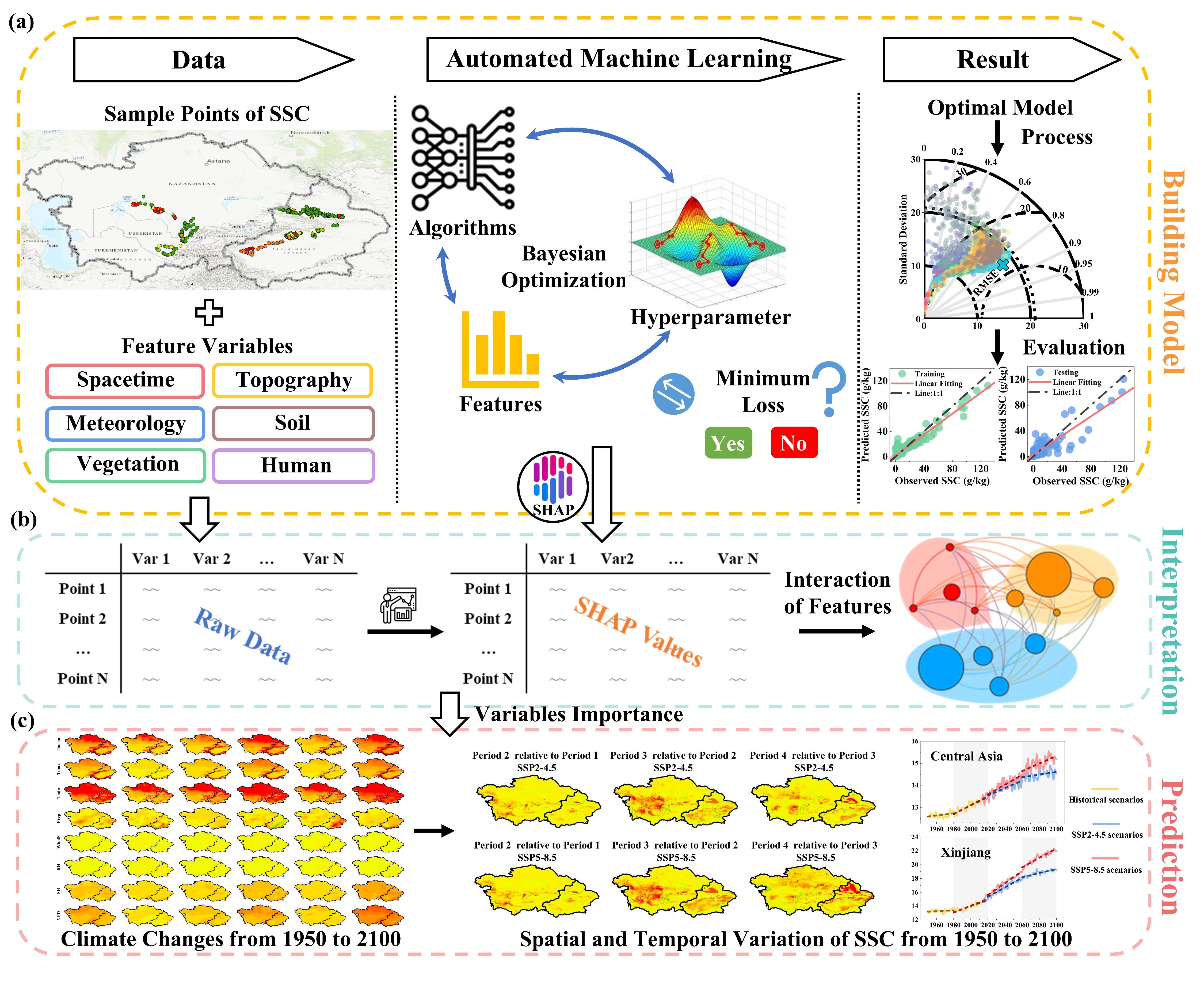
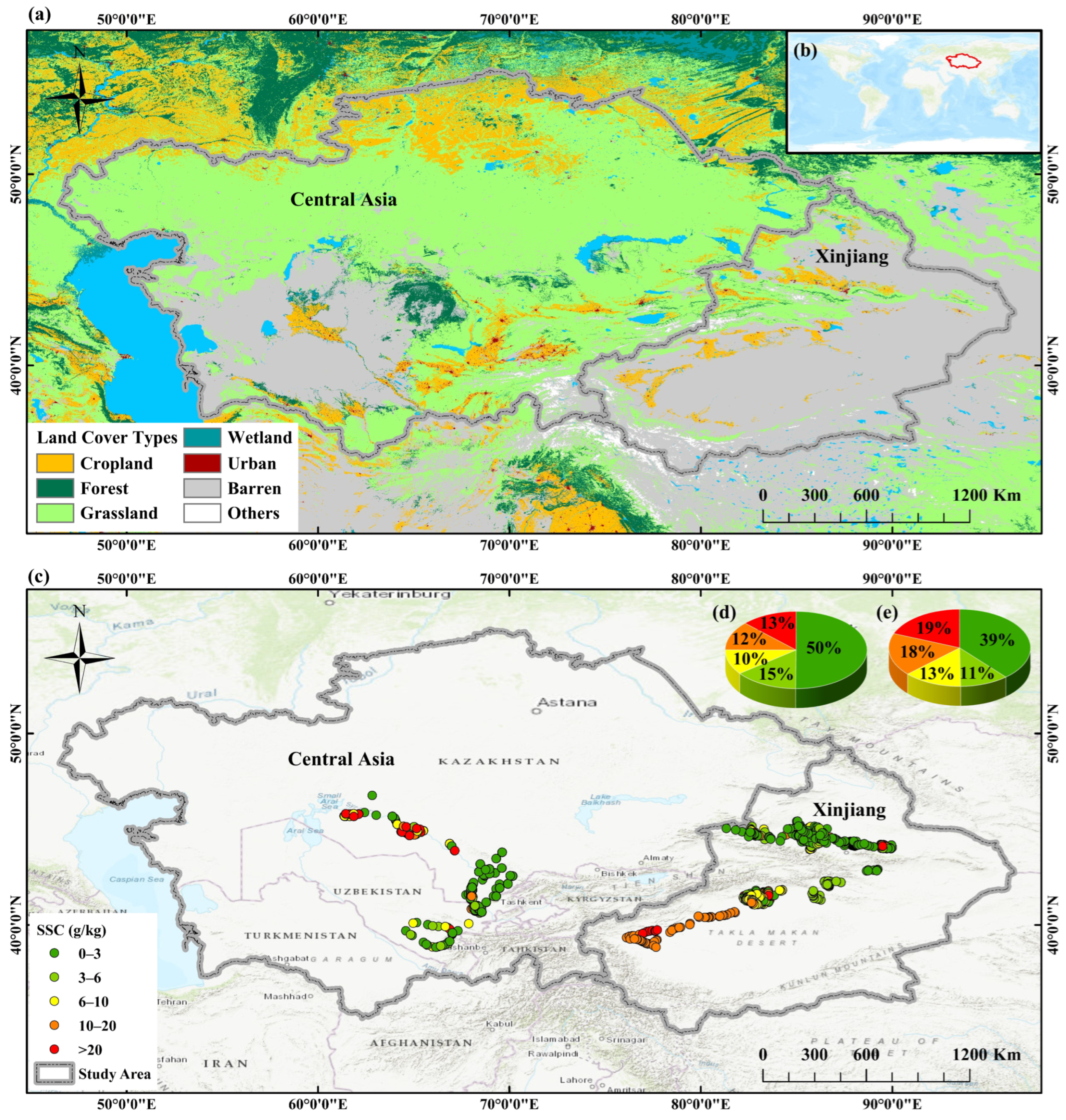
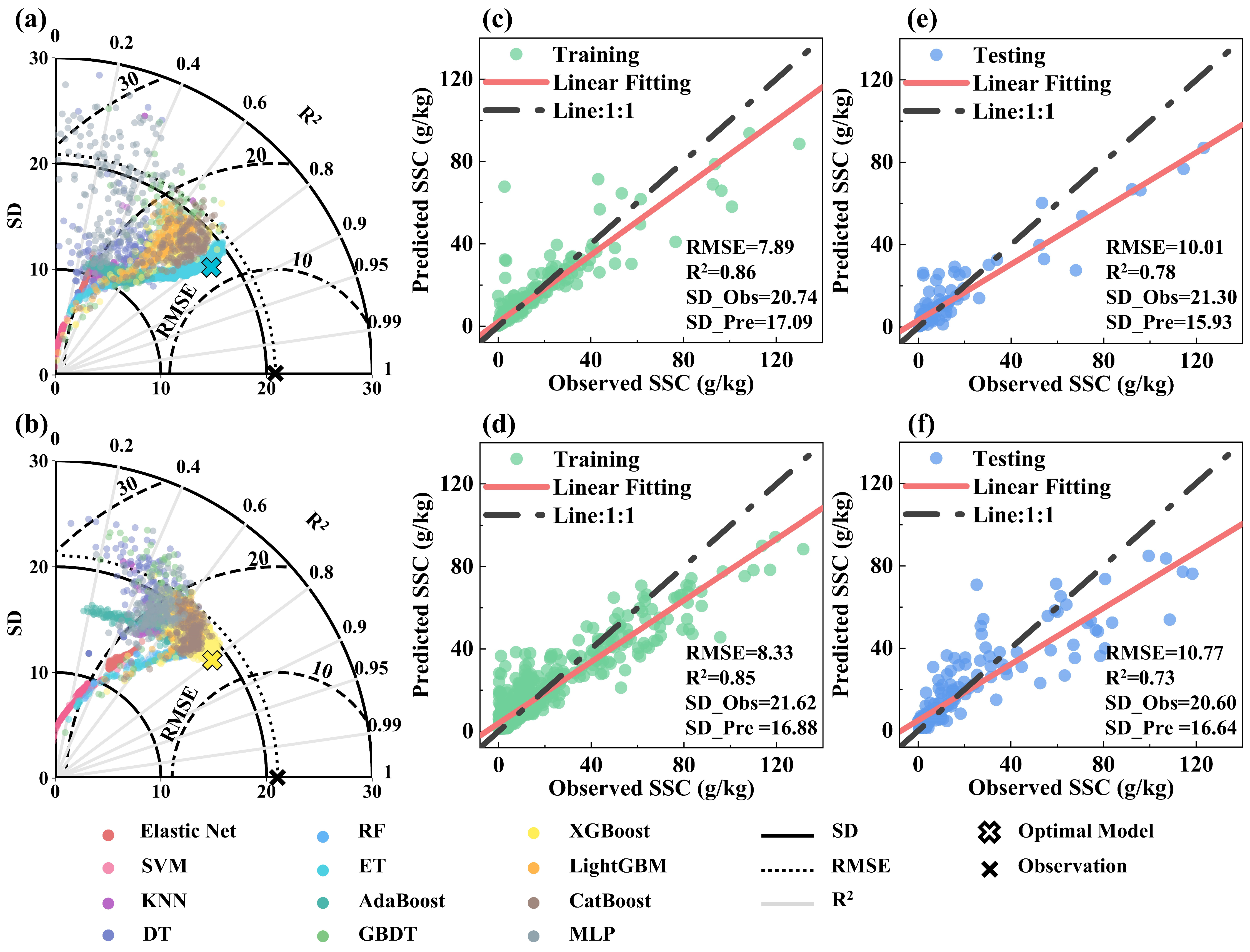

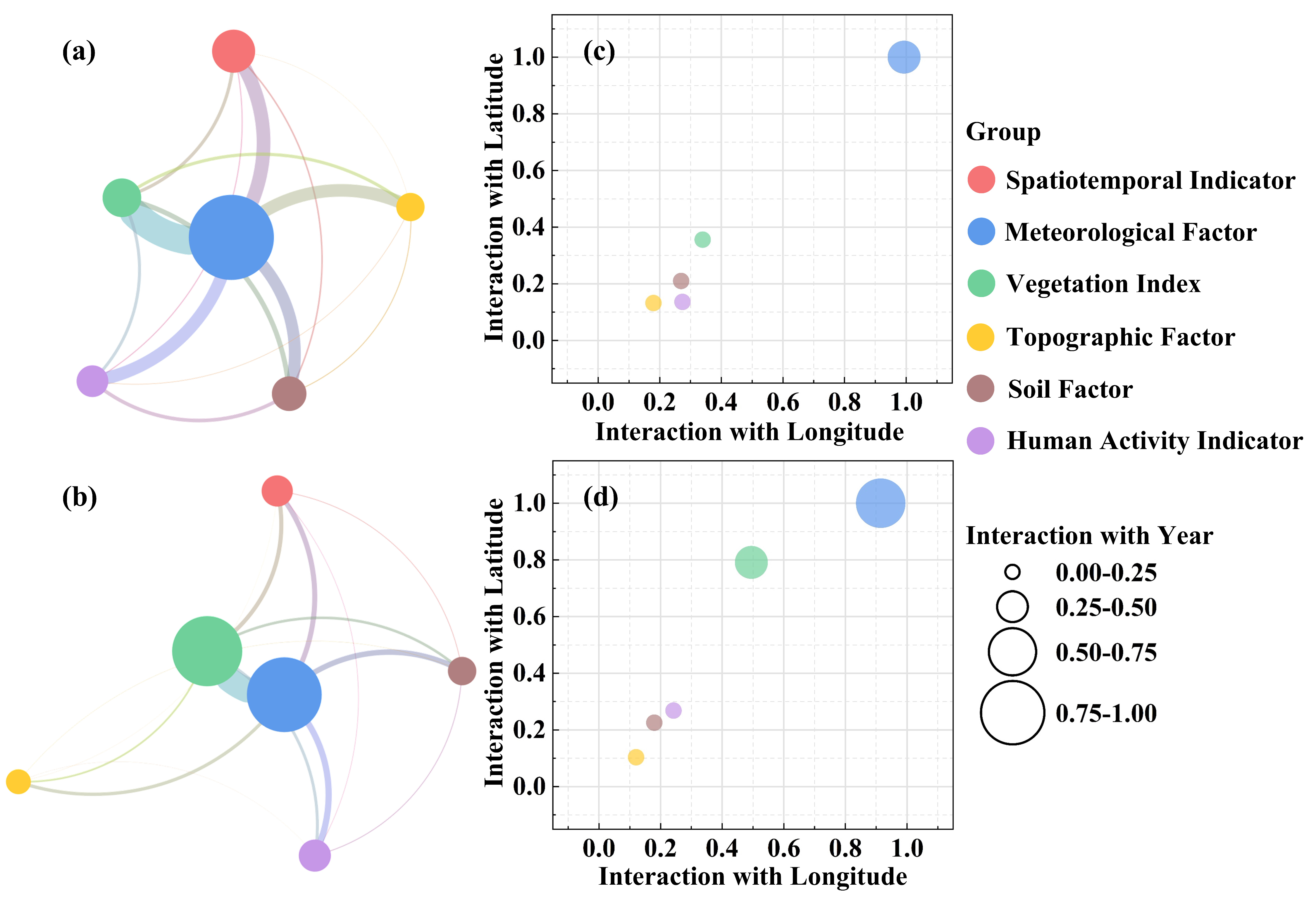
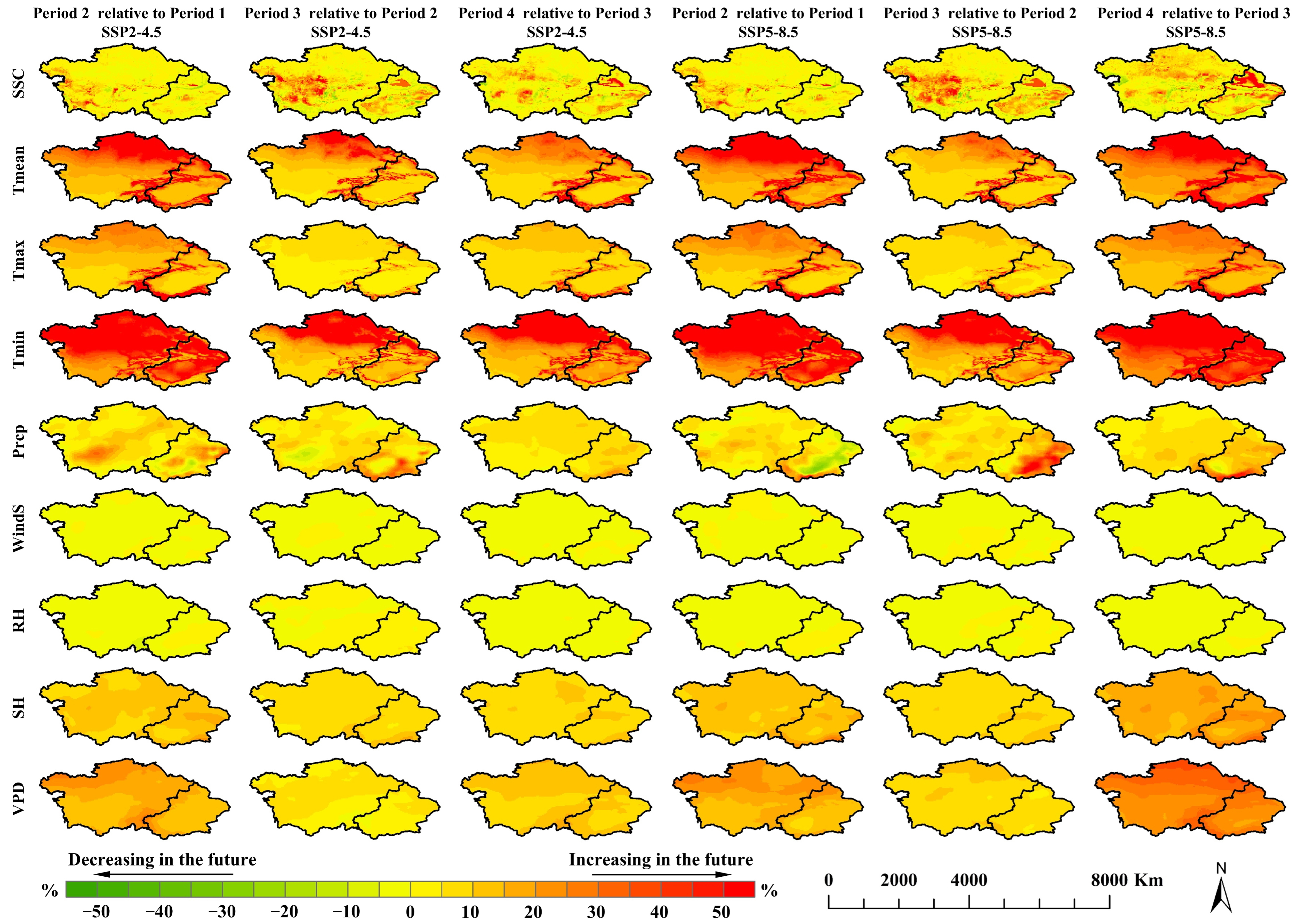
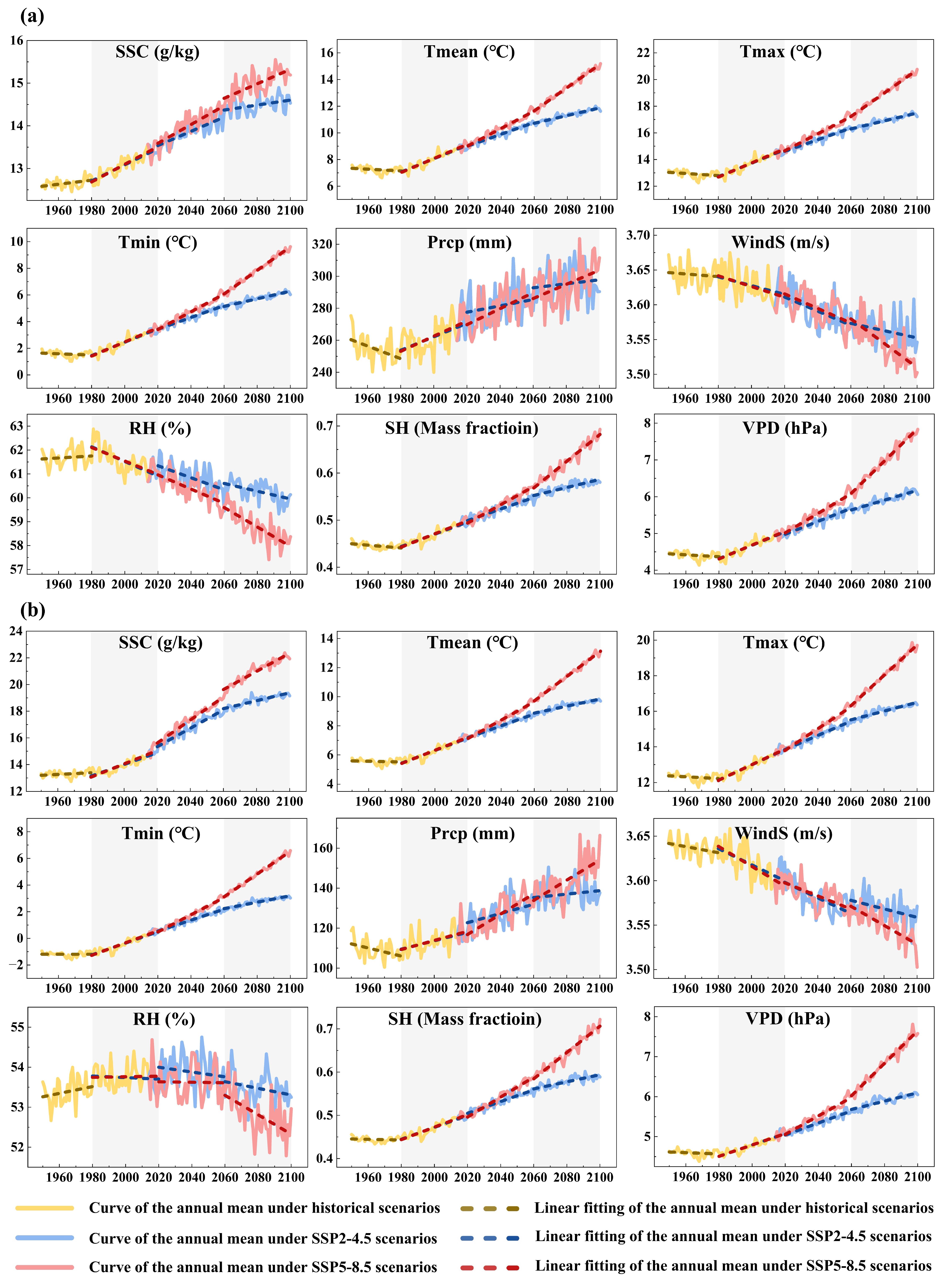
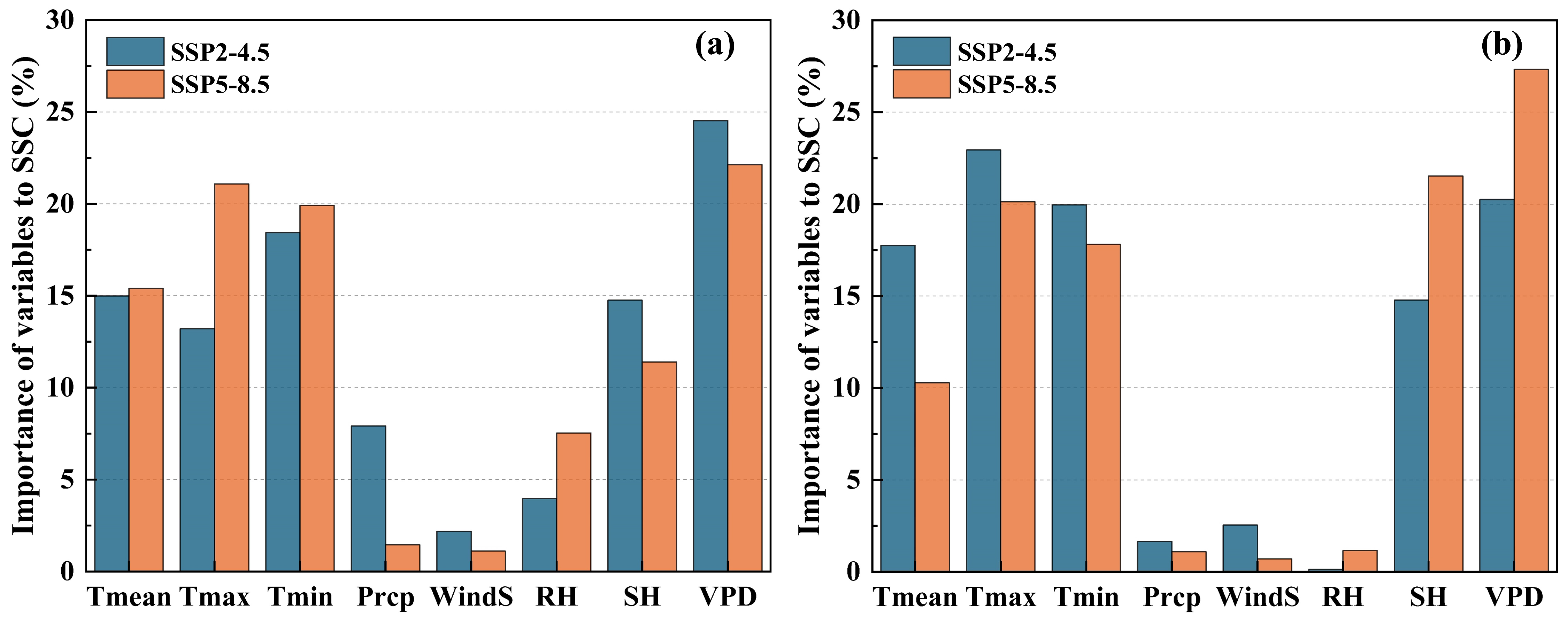
| Group | Feature | Source | Temporal/Spatial Resolution |
|---|---|---|---|
| Spatiotemporal Indicator | Year, Latitude (Lat), Longitude (Lon) | Field Investigation | — |
| Meteorological Factor | Mean Air Temperature (Tmean) | GEE ‘NASA/GDDP-CMIP6’ | daily/0.25° |
| Maximum Air Temperature (Tmax) | ditto | ditto | |
| Minimum Air Temperature (Tmin) | ditto | ditto | |
| Precipitation (Prcp) | ditto | ditto | |
| Wind Speed (WindS) | ditto | ditto | |
| Relative Humidity (RH) | ditto | ditto | |
| Specific Humidity (SH) | ditto | ditto | |
| Vapor Pressure Deficit (VPD) | ditto | ||
| Evapotranspiration (ET) | GEE ‘NASA/FLDAS/NOAH01/C/GL/M/V001’ | monthly/0.1° | |
| Vegetation Index | Normalized Difference Vegetation Index (NDVI) | (NIR − Red)/(NIR + Red) | daily/500 m |
| Enhanced Vegetation Index (EVI) | 2.5 × ((NIR − Red)/(NIR + 6 × Red − 7.5 × Blue + 1)) | ditto | |
| Normalized Difference Water Index (NDWI) | (Green − NIR)/(Green + NIR) | ditto | |
| Land Surface Water Index (LSWI) | (NIR − SWIR1)/(NIR + SWIR1) | ditto | |
| Leaf Area Index (LAI) | GEE ‘MODIS/061/MCD15A3H’ | 4-day/500 m | |
| Fraction of Photosynthetically Active Radiation (FPAR) | ditto | ditto | |
| Standardized Precipitation Evapotranspiration Index (SPEI) | GEE ‘CSIC/SPEI/2_9’ | monthly/0.5° | |
| Topographic Factor | Elevation, Slope, Aspect, Roughness | GEE ‘USGS/SRTMGL1_003’ | Static/30 m |
| Soil Factor | Soil Moisture (SM) | GEE ‘NASA/FLDAS/NOAH01/C/GL/M/V001’ | daily/0.1° |
| Soil Temperature (Tsoil) | ditto | ditto | |
| Soil Bulk Density (Bulk) | Harmonized World Soil Database | static/1 km | |
| Soil Texture (Texture) | ditto | ditto | |
| Soil pH (PH) | ditto | ditto | |
| Soil Organic Carbon (SOC) | ditto | ditto | |
| Soil Clay Fraction (Clay) | ditto | ditto | |
| Soil Sand Fraction (Sand) | ditto | ditto | |
| Soil Silt Fraction (Silt) | ditto | ditto | |
| Human Activity Indicator | Land-use/Land-cover (LULC) | GEE ‘MODIS/061/MCD12Q1’ | yearly/500 m |
| Global Livestock Distribution (Livestock) | FAO Livestock Systems | static/5 arc-minutes | |
| Cultivated Area (CA) | World Bank Open Data | Statistic | |
| Per Capita GDP (GDP) | ditto | ditto | |
| Population Density (Population) | ditto | ditto |
| Model | Hyperparameters |
|---|---|
| Elastic Net | alpha, L1_ratio |
| Support Vector Machine | C, kernel |
| K-Nearest Neighbor | n_neighbors, weights, p |
| Decision Tree | max_depth, min_samples_leaf, min_samples_split, max_features |
| Random Forest | n_estimators, max_depth, max_leaf_nodes, min_samples_leaf, min_samples_split, max_features |
| Extremely Randomized Trees | n_estimators, max_depth, min_samples_leaf, min_samples_split, max_features |
| Adaptive Boosting | n_estimators, learning_rate, loss |
| Gradient Boosting Decision Tree | n_estimators, subsample, max_depth, learning_rate, min_samples_leaf, min_samples_split, max_features |
| eXtreme Gradient Boosting | n_estimators, subsample, max_depth, learning_rate, colsample_bytree, gamma, reg_alpha, reg_lambda |
| Light Gradient Boosting Machine | num_leaves, n_estimators, subsample, max_depth, learning_rate, colsample_bytree, min_child_weight, min_child_samples, reg_alpha, reg_lambda |
| Categorical Boosting | subsample, learning_rate, l2_leaf_reg, colsample_bylevel, depth, min_data_in_leaf, one_hot_max_size |
| Multilayer Perceptron | hidden_layer_sizes, activation, alpha, learning_rate, learning_rate_init |
Disclaimer/Publisher’s Note: The statements, opinions and data contained in all publications are solely those of the individual author(s) and contributor(s) and not of MDPI and/or the editor(s). MDPI and/or the editor(s) disclaim responsibility for any injury to people or property resulting from any ideas, methods, instructions or products referred to in the content. |
© 2025 by the authors. Licensee MDPI, Basel, Switzerland. This article is an open access article distributed under the terms and conditions of the Creative Commons Attribution (CC BY) license (https://creativecommons.org/licenses/by/4.0/).
Share and Cite
Wang, L.; Hu, P.; Zheng, H.; Bai, J.; Liu, Y.; Hellwich, O.; Liu, T.; Chen, X.; Bao, A. An Automated Framework for Interaction Analysis of Driving Factors on Soil Salinization in Central Asia and Western China. Remote Sens. 2025, 17, 987. https://doi.org/10.3390/rs17060987
Wang L, Hu P, Zheng H, Bai J, Liu Y, Hellwich O, Liu T, Chen X, Bao A. An Automated Framework for Interaction Analysis of Driving Factors on Soil Salinization in Central Asia and Western China. Remote Sensing. 2025; 17(6):987. https://doi.org/10.3390/rs17060987
Chicago/Turabian StyleWang, Lingyue, Ping Hu, Hongwei Zheng, Jie Bai, Ying Liu, Olaf Hellwich, Tie Liu, Xi Chen, and Anming Bao. 2025. "An Automated Framework for Interaction Analysis of Driving Factors on Soil Salinization in Central Asia and Western China" Remote Sensing 17, no. 6: 987. https://doi.org/10.3390/rs17060987
APA StyleWang, L., Hu, P., Zheng, H., Bai, J., Liu, Y., Hellwich, O., Liu, T., Chen, X., & Bao, A. (2025). An Automated Framework for Interaction Analysis of Driving Factors on Soil Salinization in Central Asia and Western China. Remote Sensing, 17(6), 987. https://doi.org/10.3390/rs17060987






